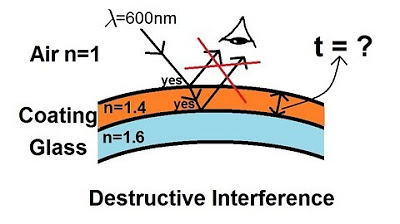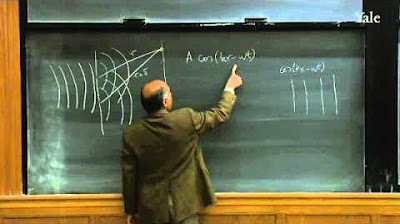Physics 60 Interference of Light (6 of 8) The Thin Film: Oil
TLDRThe video discusses the phenomenon of light reflection in a thin film, using an example of a puddle with a thin oil layer. When light shines on the puddle, different colors appear due to varying wavelengths. The video explains how an observer sees yellow light reflected and determines the oil film's thickness needed for this reflection. It covers concepts such as phase shifts at boundaries, wavelength adjustments in different mediums, and calculations to find the oil film's thickness, concluding that it should be 89 nanometers for yellow light reflection.
Takeaways
- 🌈 The phenomenon described is the interference of light reflecting off an oil film on water, creating colorful patterns due to varying thicknesses of the oil layer.
- 🔬 The observer sees yellow light being reflected from a particular spot on the oil film, which suggests a specific thickness related to the wavelength of yellow light.
- 🌟 Sunlight contains a spectrum of colors, but only yellow light is being reflected back to the observer, indicating a resonance condition with the film's thickness.
- 📏 The thickness of the oil film is critical for the constructive interference of yellow light, which requires the path difference to be an integer multiple of the wavelength.
- 🔄 A phase shift occurs at the boundary where light reflects from a medium with a lower to a higher index of refraction, affecting the interference pattern.
- 🔄 There is a 180-degree phase shift (half-wavelength) at the air-oil boundary due to the higher index of refraction of oil compared to air.
- 🔄 No phase shift occurs at the oil-water boundary because the light is moving from oil (higher index) to water (lower index).
- 📐 The extra distance traveled by the light through the oil film must be half a wavelength to achieve constructive interference for yellow light.
- 🔢 The formula to calculate the thickness of the oil film is derived from the condition that twice the thickness (2T) equals half the wavelength of yellow light in the oil (λ/2n).
- 📐 The wavelength of light in the oil is adjusted by the index of refraction (n), which is why λ/2n is used instead of just λ/2.
- 📝 The calculated thickness for the oil film to reflect yellow light is approximately 89 nanometers, based on the given index of refraction for oil and the wavelength of yellow light.
Q & A
What causes the different colors seen when oil is floating on water?
-The different colors are caused by the interference of light waves reflecting off the thin oil film on the water's surface. This phenomenon is known as thin-film interference.
Why is only yellow light being reflected in the given example?
-Yellow light is being reflected because the thickness of the oil film has been such that it constructively interferes with the yellow wavelength of light, while other wavelengths are either transmitted or destructively interfered with.
What is the significance of the extra distance traveled by the light ray that reflects off the boundary between oil and water?
-The extra distance traveled by the light ray is crucial because it determines the phase difference between the light waves reflecting off the top and bottom surfaces of the oil film, which in turn affects the color seen by the observer.
Why is there a phase shift when light is reflected off a boundary where the index of refraction is greater on the other side?
-A phase shift occurs at a boundary when light is reflected because the light wave changes from a medium with a lower index of refraction to one with a higher index, causing a half-wave shift in the reflected light.
Why is there no phase shift when light reflects off the boundary between oil and water?
-There is no phase shift at the oil-water boundary because the light is moving from a medium with a higher index of refraction (oil) to one with a lower index (water), which does not cause a half-wave shift.
What is the initial phase difference between the two beams of light reflecting off the oil film?
-The initial phase difference is a half-wavelength because of the phase shift at the air-oil boundary and the lack of a phase shift at the oil-water boundary.
What condition is needed for the two waves to constructively interfere and produce yellow light?
-For constructive interference to occur and produce yellow light, the extra distance traveled by the light through the oil must be a half-wavelength, compensating for the initial half-wavelength phase difference.
How does the index of refraction affect the wavelength of light in the oil?
-The wavelength of light changes when it enters a medium with a different index of refraction. In the case of oil, the wavelength is reduced because the index of refraction of oil is greater than that of air.
What formula is used to calculate the thickness of the oil film that results in the reflection of yellow light?
-The formula used is T = \frac{\lambda}{4n}, where T is the thickness of the oil film, \lambda is the wavelength of yellow light in air, and n is the index of refraction of the oil.
What is the calculated thickness of the oil film for the observer to see yellow light being reflected?
-The calculated thickness of the oil film is 89 nanometers, which is sufficient for the observer to see yellow light being reflected off the film.
Outlines
🌈 Understanding Light Reflection on Thin Films
This paragraph explains the phenomenon of light reflection on a thin film, such as a layer of oil on water. It describes how sunlight, composed of various colors, can cause different colors to appear when reflected from such a film. The focus is on determining the thickness of the oil layer required for an observer to see yellow light being reflected. The explanation includes the concept of light traveling through the oil, reflecting off the oil-water boundary, and how the thickness of the oil affects the phase difference between light waves, ultimately determining the color observed.
🔬 Calculating Oil Film Thickness for Yellow Light Reflection
This paragraph continues the explanation by calculating the exact thickness of the oil layer needed for yellow light reflection. It delves into the physics of phase shifts at different boundaries, the importance of considering the index of refraction, and how these factors contribute to the light's wavelength in the oil. The calculation concludes that for yellow light (500 nm), the oil layer must be 89 nanometers thick for the observer to see yellow light reflected, rather than transmitted into the water. This provides a practical example of solving a thin-film interference problem.
Mindmap
Keywords
💡Thin film
💡Interference
💡Reflection
💡Phase difference
💡Wavelength
💡Constructive interference
💡Destructive interference
💡Refraction
💡Index of refraction
💡Phase shift
💡Sunlight
Highlights
The phenomenon of different colors being reflected off an oil film on water when light shines on it, creating colorful rings.
The requirement for the oil film to be a specific thickness to reflect yellow light back to the observer.
Sunlight contains all colors of the rainbow, but only yellow light is being reflected in the example.
The concept that the extra distance traveled by light through the oil film is equal to twice the thickness of the oil.
Phase difference for yellow light reflection to be 0, implying constructive interference.
The importance of considering phase shifts at boundaries with different indices of refraction.
A phase shift occurs when light is reflected off a boundary where the index of refraction on the other side is greater.
No phase shift when the index of refraction on the other side is smaller than where the light came from.
The initial phase difference due to the reflection off the first boundary is a half-wavelength.
The condition for constructive interference requires making up the other half-wavelength.
The wavelength of light in the oil is different due to the change in the index of refraction.
The formula for calculating the thickness of the oil film: 2T = (1/2 * λ) / n.
Solving for the thickness T gives T = λ / (4n), accounting for the wavelength and index of refraction.
The example calculation for yellow light at 500 nanometers with an index of refraction of 1.4 for oil.
The resulting thickness of the oil film required for yellow light reflection is 89 nanometers.
The explanation of how the thickness of the oil film affects the color seen by the observer.
Transcripts
5.0 / 5 (0 votes)
Thanks for rating:





